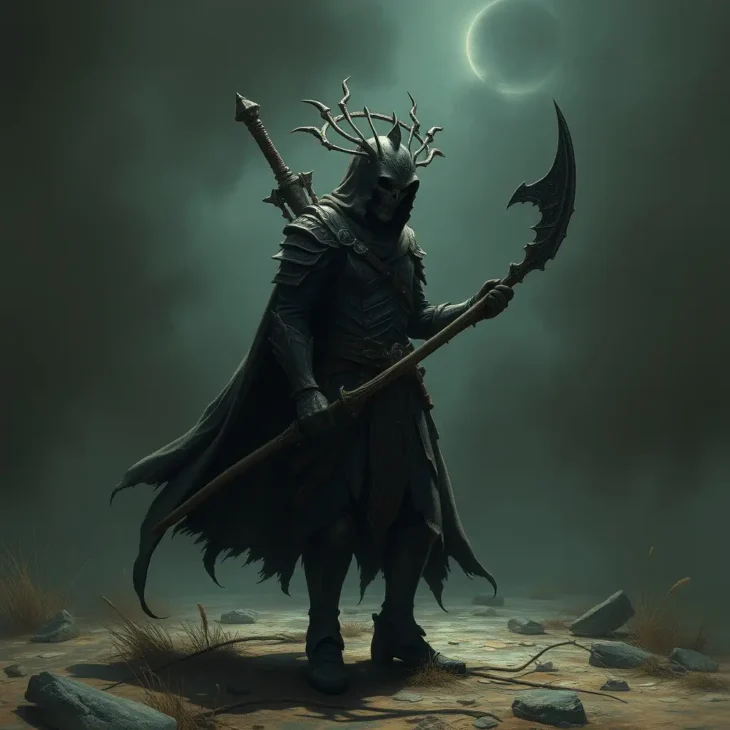The Churels (India & Pakistan): South Asian Folklore

In the rich tapestry of South Asian folklore, one captivating supernatural entity stands out – the Churels. These mythical female ghosts are deeply rooted in the cultural traditions of India, Bangladesh, Nepal, and Pakistan, captivating the imagination of people across the region. Churels are believed to be the spirits of women who met their demise during childbirth, pregnancy, or due to mistreatment, rising from the realm of the dead with a vengeful nature and a thirst for retribution.
The legend of the Churel has evolved and taken on various regional nuances, with different types and characteristics attributed to these otherworldly beings. From the Poshi churels to the Soshi and Toshi churels, each variation adds to the intricate and unsettling tapestry of South Asian folklore. Wherever they are reported – in graveyards, cemeteries, abandoned battlefields, or the thresholds of homes – Churels command a sense of fear and fascination.
Key Takeaways
- Churels are mythical female ghosts deeply rooted in South Asian folklore, particularly in India, Bangladesh, Nepal, and Pakistan.
- They are believed to be the spirits of women who died during childbirth, pregnancy, or due to mistreatment, rising with a vengeful nature.
- The legend of the Churel has evolved with various regional variations, including Poshi, Soshi, and Toshi churels.
- Churels are reported to haunt a variety of locations, from graveyards to the thresholds of homes, instilling fear and fascination.
- The origins of the Churel legend can be traced back to Persia, with the concept evolving and adapting across South Asia.
Origins and History of Churel Legends
The captivating legend of the Churel, an Indian folklore horror of a revengeful female spirit, has its roots deeply embedded in the rich cultural tapestry of South Asia. Tracing its origins to Persia, the Churel myth evolved over time, weaving a tapestry of regional variations that continues to captivate audiences across the Indian subcontinent.
Persian Origins and Evolution
The Churel legend first emerged in Persia, where it described spirits of women who had died with “grossly unsatisfied desires.” As the legend spread across South Asia, it morphed to include women who had passed away during childbirth or the “period of impurity,” a concept deeply rooted in certain cultural beliefs.
Regional Variations Across South Asia
Throughout South Asia, the Churel has taken on various guises, reflecting the diverse cultural and linguistic traditions of the region. In Punjab, they are known as Pichal Peri, while in Bengal, they are referred to as Petni or Shakchunni. Across the border in Malaysia and Indonesia, the Churel’s counterpart is the Pontianak, a testament to the widespread influence of this captivating legend.
Historical Documentation and Cultural Significance
The Churel legend has been extensively documented in colonial-era writings and folklore studies, highlighting its profound cultural significance in shaping social behaviors and beliefs across the Indian subcontinent. This enduring folklore continues to captivate audiences, serving as a stark reminder of the enduring power of storytelling to explore themes of tragedy, womanhood, and the monstrous.
Understanding The Churels (India & Pakistan)
Churels are complex supernatural beings deeply rooted in South Asian folklore, often associated with tragedy and revenge. These ghostly entities are believed to be created from women who died in childbirth, during pregnancy, or due to neglect and mistreatment. Exploring the Churel myth offers insights into cultural narratives, social behaviors, and societal fears surrounding death, sexuality, and gender roles.
Legends state that if a woman dies due to tragic or unnatural causes, she might return as a Churel – a “ghost of an unpurified living thing.” There are countless stories of Churels dating back to ancient times, with modern accounts of sightings, such as the famous tale of a woman in a red wedding dress haunting Karzaz Road in Karachi, Pakistan.
The Churel myth reflects societal views on the mistreatment of women, serving as a powerful symbol challenging traditional gender norms. These spirits are often depicted with the ability to transform from horrifying to beautiful, highlighting their cunning and intelligence. The Churel narrative serves as a wake-up call to society, emphasizing the importance of equality and respect in gender dynamics.
Contemporary adaptations, like the upcoming web series “Churails,” aim to reclaim the true value of the Churel myth, portraying these female figures as strong and empowered. The Churel’s role as a symbol of retaliation and justice reflects the ongoing efforts to challenge societal prejudices and give voice to the struggles of women in South Asian cultures.
Physical Appearance and Transformation Powers
In the realm of Indian folklore, the Churel, a supernatural entity, is often depicted as a truly horrifying sight. Described as having a hideous true form, the Churel is said to possess a sagging, deformed body with a black tongue, thick and rough lips, and a pot belly. Their hands are claw-like, and their hair is long and wild. One of the most distinctive features of the Churel is their backwards-facing feet, a trait that evokes a sense of unease and the uncanny.
However, the Churel’s true power lies in their shape-shifting abilities. These eerie beings can transform themselves into the guise of beautiful young women, using their captivating appearance to lure unsuspecting victims, particularly men. This duality in appearance reflects the Churel’s deceptive and dangerous nature, as they prey on the unsuspecting with their ghostly backwards feet and Indian folklore horror.
Shape-shifting Abilities
The Churel’s shape-shifting powers are a crucial aspect of their folkloric legend. These supernatural entities can seamlessly transition from their hideous true form to a stunningly beautiful facade, allowing them to blend in with society and catch their victims off guard. This shape-shifting ability serves as a potent tool in the Churel’s arsenal, enabling them to lure men and enact their vengeful desires.
Distinctive Physical Features
Beyond their shape-shifting prowess, the Churel is also known for their distinctive physical features. Their sunken, lifeless eyes, coupled with their backwards-facing feet, create an unsettling and disorienting appearance that strikes fear into the hearts of those who encounter them. The Churel’s long, tangled hair and sharp, claw-like hands further contribute to their haunting and otherworldly presence, cementing their status as a truly terrifying backwards feet ghost in Indian folklore horror.
Creation and Circumstances of Becoming a Churel
In the captivating realm of Indian folklore, the revengeful female spirit known as the Churel holds a prominent place. These Indian folklore horror entities are believed to arise under specific circumstances, often associated with the tragic loss of life during childbirth, pregnancy, or menstruation.
Across South Asia, the transformation into a Churel is frequently linked to neglect or mistreatment by family members. In some regions, women who die an unnatural death, such as during the auspicious festival of Diwali, are also thought to become these vengeful spirits. The beliefs surrounding the creation of Churels reflect the intricate tapestry of local customs and superstitions that have evolved over time.
In Western India, particularly in Gujarat, any woman who perishes in an unnatural manner is believed to transform into a Churel, also known by various regional names like jakihn, jakhai, mukai, nagulai, and alvantin. Similarly, in South-East Asia, a woman can become a Churel if she passes away during childbirth, while pregnant, or during the “period of impurity” – the twelve days after giving birth.
The beliefs surrounding the creation of Churels are deeply rooted in the cultural fabric of South Asia, reflecting the region’s unique folklore and superstitions. These revengeful female spirits continue to captivate the collective imagination, serving as a testament to the enduring power of Indian folklore horror traditions.
Haunting Grounds and Territory
The desert supernatural encounters with the legendary Churels, the ghostly female entities in South Asian folklore, are often reported in specific locations associated with death and impurity. These elusive beings are said to haunt cemeteries, cremation grounds, abandoned battlefields, thresholds of houses, crossroads, and even public restrooms. The Churels are believed to be most active during the darkest hours of the night, when their eerie presence is felt the strongest.
Geographically, sightings of these Churel ghost encounters span across South Asia, with variations in their manifestations and behaviors in different regions and countries, including India, Pakistan, Bangladesh, and Nepal. The desert supernatural encounters with Churels have become an integral part of the cultural tapestry, captivating the imagination of people in these areas for centuries.
Preferred Locations
Churels are reported to haunt a variety of locations that are deemed impure or associated with death, such as cemeteries, cremation grounds, abandoned battlefields, thresholds of houses, crossroads, and even public restrooms. These supernatural entities are drawn to these places, seeking to linger in the energy and remnants of mortality.
Time of Activity
The Churels are said to be most active during the darkest hours of the night, when the veil between the physical and spiritual realms is believed to be the thinnest. Their eerie presence is felt the strongest in the dead of night, as they roam the haunting grounds, seeking to prey on the unsuspecting and the vulnerable.
Geographic Distribution
The Churel ghost sightings and encounters with these supernatural entities have been reported across South Asia, with variations in their manifestations and behaviors in different regions and countries. From the deserts of India and Pakistan to the remote villages of Bangladesh and Nepal, the Churels have woven themselves into the cultural tapestry of these areas, captivating the imagination of the people for centuries.
Vengeful Nature and Targeting Methods
Churels, the revengeful female spirits of Indian folklore horror, are notorious for their vengeful nature. These supernatural entities often target male family members who mistreated them in life, seeking to exact a devastating retribution. The churel’s modus operandi typically begins with the youngest male, draining his blood and life force, before moving on to other men in the family.
But the churel’s thirst for vengeance does not stop there. These malevolent spirits also have a penchant for targeting young mothers and unmarried boys. Using their captivating beauty as a lure, churels will ensnare their victims, imprisoning or even killing them. In some cases, they are believed to have the ability to transform their victims into withered, aged men by sapping their very vitality.
The churel’s merciless and indiscriminate nature has made them a feared entity in South Asian folklore. Their relentless pursuit of vengeance, coupled with their shape-shifting abilities and seductive powers, have cemented their reputation as a truly formidable and revengeful female spirit in Indian folklore horror.
Connection to Hindu Mythology and Kali
In the realm of Indian folklore, the Churels, a revengeful female spirit, are sometimes associated with the fearsome dakinis – female spirits that serve the goddess Kali. This intriguing connection links the Churels to the broader religious and mythological context of South Asian traditions, where they are often depicted as feasting on human flesh and blood.
Religious Significance
The relationship between Churels and the divine figure of Kali reflects the complex spiritual beliefs and the intertwining of different mythological narratives in the region. Kali, the fierce manifestation of the Divine Mother, is revered for her ability to destroy evil and restore balance. The association of Churels with her devotees, the dakinis, further imbues these vengeful spirits with a sense of religious significance and supernatural power.
Relationship with Other Supernatural Beings
The Churels’ connection to the Indian folklore horror of Indian folklore horror and revengeful female spirit extends beyond their ties to Kali and the dakinis. These entities are often believed to coexist and interact with other supernatural beings in South Asian folklore, such as various forms of ghosts, demons, and witches. This intricate web of mythological associations adds to the rich tapestry of Indian folklore horror and the enduring legacy of the revengeful female spirit in the region’s cultural consciousness.
Prevention Rituals and Protective Measures
In the captivating world of Indian folklore, the legends of the Churels hold a distinct and terrifying place. These ghostly entities, believed to be the spirits of women who have met untimely deaths, are said to haunt and torment the living. However, the people of South Asia have developed a rich tapestry of rituals and protective measures to ward off these Churel ghost sightings and safeguard themselves against the horrors of Indian folklore horror.
One of the most common practices is the performance of specific burial rituals for women who die during childbirth or menstruation. These rituals, which often involve the use of mustard seeds, iron nails, and red pepper, are believed to prevent the transformation of the deceased into a Churel. Additionally, some communities construct protective structures at the entrances of their villages, effectively creating a barrier against the intrusion of these malevolent spirits.
Exorcism rituals are another powerful tool used to banish Churels from the living realm. By invoking the aid of religious figures or shamans, these ceremonies are intended to cleanse the affected area and remove the Churel’s influence. The deep-rooted beliefs and fears surrounding Churel legends have given rise to a diverse array of preventive measures, reflecting the cultural significance of these supernatural entities in South Asian folklore.
Conclusion
The Churel myth in South Asian folklore, particularly in India and Pakistan, serves as a powerful representation of the societal attitudes towards women and the consequences of gender inequality and injustice. The narratives of these vengeful spirits, who return from the afterlife to haunt and seek retribution against the men who wronged them during their earthly existence, function as a stark warning to those who mistreat women.
The Churel myth highlights the resilience and might of women, even beyond the confines of mortal life. It symbolizes the severe repercussions of gender-based discrimination, especially for women who faced untimely or unnatural deaths, such as during childbirth. This myth prompts a reevaluation of societal norms and attitudes, underscoring the urgent need for empathy, respect, and justice for women in South Asian cultures.
The Churel’s intriguing qualities, including their shapeshifting abilities and their transformation from tormented spirits to vengeful apparitions, reflect the complex societal issues of fear, vengeance, and gender dynamics. The representation of Churels in literature and media further reinforces their role as symbols of feminist rebellion, challenging traditional gender norms and demanding retribution for the injustices they faced in life.
FAQ
What are Churels?
Where did the Churel legend originate?
What are the regional variations of Churel legends?
How are Churels described in their true form?
What are the circumstances under which women become Churels?
Where do Churels haunt?
How do Churels target their victims?
What is the connection between Churels and Hindu mythology?
How do communities protect against Churels?
Source Links
- Churel
- The Witches That Terrified Me as a Kid Are Actually Feminist Heroes
- The Churel and other mythical legends
- Churel
- Supernatural Tales and Legends From Around the World: The Churel
- Churel Indian Vengeful Female Spirit – Mythology Vault
- Churel: The Vengeful Ghost of South Asian Folklore – Horror Chronicles
- “The Witch’s Mirror”: A Review of Scholarship on Witchcraft and a Reassessment Based on the Intersectional Lived Experiences of Dalits and Adivasis
- Churel
- Malicious Myths: The Churel (चुडैल)
- Blood Brothers: The Ramsay Film History
- On Uncertain Ground: A Study of Displaced Kashmiri Pandits in Jammu and Kashmir 0199466777, 9780199466771 – DOKUMEN.PUB
- Haunters or Haunted?: A Feminist Anatomization of Female Ghosts (Shakchunni, Sheekol Buri, and Prapti) from Bengali Folk Tales through the Prism of Biological Essentialism
- Mythology – Page 2 – In The Dark Air
- Dayan (witch)
- South Asia – In The Dark Air
- Ghost
- What does churel mean?
- Demons and Ghosts in Indian Folklore





